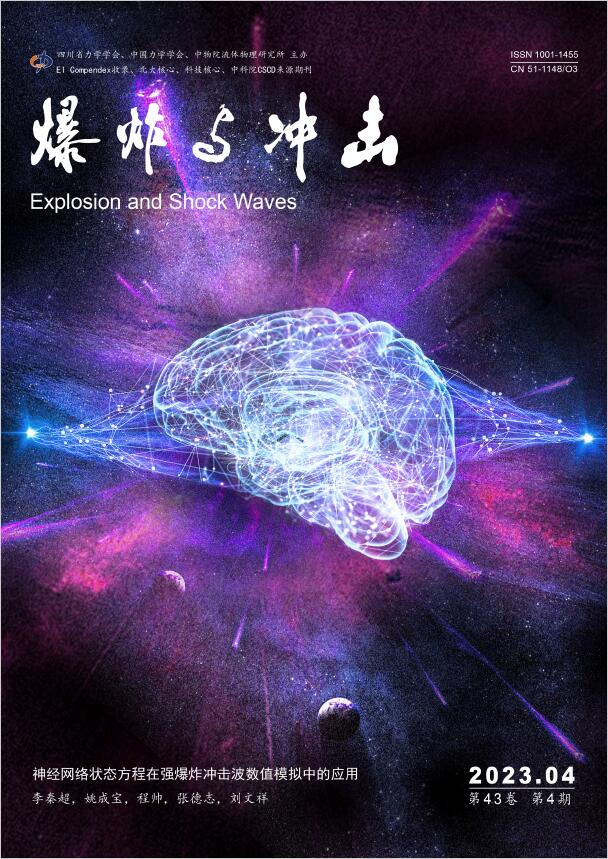| [1] |
SWIFT H F. Light-gas gun technology: a historical perspective [M]//CHHABILDAS L C, DAVISON L, HORIE Y. High-Pressure Shock Compression of Solids Ⅷ. Berlin: Springer, 2005: 1–35.
|
| [2] |
LEXOW B, WICKERT M, THOMA K, et al. The extra-large light-gas gun of the fraunhofer EMI: applications for impact cratering research [J]. Meteoritics & Planetary Science, 2013, 48(1): 3–7. DOI: 10.1111/j.1945-5100.2012.01427.x. |
| [3] |
HUNEAULT J, LOISEAU J, HIGGINS A J. Coupled lagrangian gasdynamic and structural hydrocode solvers for simulating an implosion-driven hypervelocity launcher [C]//Proceedings of the 51st AIAA Aerospace Sciences Meeting including the New Horizons Forum and Aerospace Exposition. Grapevine: AIAA, 2013: 1–21. DOI: 10.2514/6.2013-274. |
| [4] |
HUNEAULT J, LOISEAU J, HILDEBRAND M, et al. Down-bore velocimetry of an explosively driven light-gas gun [J]. Procedia Engineering, 2015, 103: 230–236. DOI: 10.1016/j.proeng.2015.04.031. |
| [5] |
HUNEAULT J. Development of an implosion-driven hypervelocity launcher for orbital debris impact simulation [D]. Montreal: McGill University, 2013: 3–10.
|
| [6] |
MORITOH T, KAWAI N, NAKAMURA K G, et al. Three-stage light-gas gun with a preheating stage [J]. Review of Scientific Instruments, 2004, 75(2): 537–540. DOI: 10.1063/1.1641155. |
| [7] |
LIN J D, ZHANG X R, ZHU Y R, et al. The technique of three-stage compressed-gas gun for hypervelocity impact [J]. Explosion and Shock Waves, 2012, 32(5): 483–489. DOI: 10.11883/1001-1455(2012)05-0483-07. |
| [8] |
HILDEBRAND M. Concepts for increasing the projectile velocity of an implosion driven launcher [D]. Montreal: McGill University, 2016: 1–2.
|
| [9] |
CHRISTIANSEN E L. Meteoroid/debris shielding: NASA/TP-2003-210788 [R]. NASA, 2003.
|
| [10] |
WANG Q S, WANG X, HAO L, et al. Progress on hypervelocity launcher techniques using a three-stage gun [J]. Chinese Journal of High Pressure Physics, 2014, 28(3): 339–345. DOI: 10.11858/gywlxb.2014.03.012. |
| [11] |
王海福, 冯顺山, 刘有英. 空间碎片导论 [M]. 北京: 科学出版社, 2010: 1–5.
|
| [12] |
SEIGEL A E. The theory of high speed guns [R]. Paris: Advisory Group for Aerospace Research and Development, 1965.
|
| [13] |
PUTZAR R, SCHAEFER F. Concept for a new light-gas gun type hypervelocity accelerator [J]. International Journal of Impact Engineering, 2016, 88: 118–124. DOI: 10.1016/j.ijimpeng.2015.09.009. |
| [14] |
李维新. 一维不定常流与冲击波 [M]. 北京: 国防工业出版社, 2003: 439–445.
|
| [15] |
北京工业学院八系《爆炸及其作用》编写组. 爆炸及其作用(上册) [M]. 北京: 国防工业出版社, 1979: 190–195.
|
| [16] |
Century Dynamics Inc. Autodyn user's manual: version 6.1 [M]. Houston: Century Dynamics Inc., 2005.
|










 DownLoad:
DownLoad:












